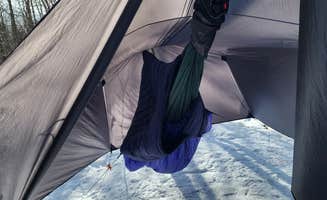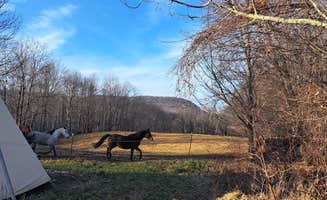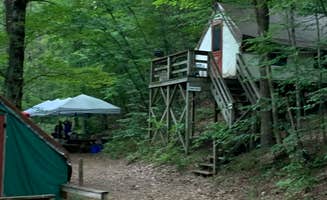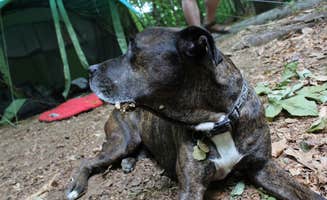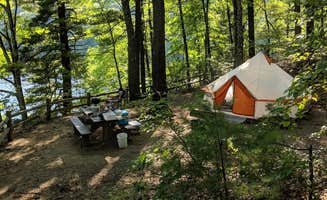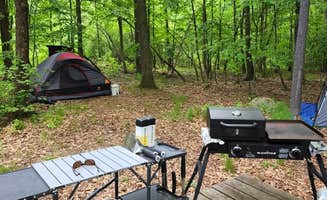Tent camping around Bennington, Vermont offers backcountry experiences in the southern Green Mountains, where elevations range from 600 to 3,940 feet. The region features hardwood forests transitioning to spruce-fir at higher elevations, with camping seasons typically running May through October. Winter conditions can persist into late spring at higher elevations, with summer temperatures averaging 75°F during peak camping months.
What to do
Trail exploration: From Stratton Pond Shelter, access multiple hiking networks. This shelter sits "at the intersection of AT, LT and Stratton Mountain trail" according to Miccal M., offering connectivity to Vermont's most established long-distance routes. The shelter requires a 3.75-mile hike from the nearest winter parking lot.
Paddling opportunities: Explore natural water features near camping areas. Stratton Pond represents one of the larger water bodies along the Long Trail system, providing paddling options for those willing to carry small craft. The pond creates a distinctive destination for hikers seeking water access in an otherwise mountainous landscape.
River activities: Access whitewater opportunities near Zoar Outdoor. Located within driving distance of Bennington, this campground connects to "adventure/outing company that provides white water rafting, tubing and other water activities on a nearby river," notes Seth K. Local swimming holes where "locals jump off outcrops into the lazy river" provide more casual water recreation.
What campers like
Privacy between sites: Maple Ridge Farm offers secluded tent camping. This private campground features "lush campground, plenty of space and privacy between sites," according to Les R., who noted the owners will "drive you in an ATV up to some of the sites that are further away from the parking lot." The property maintains natural buffers between campsites.
Common areas: Shared social spaces enhance the camping experience. Maple Ridge Farm provides a "common room that has games and eggs for sale," reports Les R., creating opportunities for campers to gather during inclement weather. Such facilities supplement the wilderness experience with practical conveniences.
Dispersed camping options: Ushers Road State Forest provides flexibility for site selection. Within this New York forest near the Vermont border, "camping is permitted anywhere in the woods as long as it's at least 150 feet off the trail," according to The L. This creates "an abundance of potential camping spots" beyond the established sites with existing fire rings.
What you should know
Water availability varies: Plan accordingly for each location. At backcountry sites like Seth Warner Shelter, no drinking water sources exist, requiring hikers to carry sufficient supply or treatment systems. Conversely, established sites like Zoar Outdoor provide potable water access at central facilities.
Regulations differ by site: Research restrictions before arrival. Several locations prohibit pets, including Seth Warner Shelter, while others like Cherry Plain Sanctuary Farm welcome them. Fire regulations also vary, with some sites permitting fires in established rings and others prohibiting them entirely.
Seasonal considerations: Weather impacts accessibility. Winter access to higher-elevation shelters requires additional planning. Stratton Pond Shelter campers report cold conditions into late spring, with one visitor noting "Cold, Snow, Wind" during a February stay, requiring winter hiking gear for the 3.75-mile approach.
Tips for camping with families
Convenient site access: Choose locations with shorter carrying distances. Campsites at Camden Creek Farm offer both drive-in and walk-in options, minimizing the distance parents must transport gear when camping with children. This reduces the logistics burden when managing family equipment.
Facilities assessment: Prioritize sites with appropriate amenities. Families may prefer locations with toilet facilities rather than backcountry options requiring wilderness bathroom practices. Several established sites offer drinking water access, reducing the amount families need to carry.
Activity planning: Select campgrounds near age-appropriate recreation. Locations near gentle water features provide natural play opportunities for children, while those with shorter trail networks allow for manageable daytime excursions with younger campers. Sites with common areas offer rainy-day alternatives.
Tips from RVers
Access limitations: Most tent-focused sites near Bennington restrict RV access. The narrow, winding roads leading to many Green Mountain camping areas present challenges for larger vehicles. Tents provide greater flexibility for reaching remote destinations inaccessible to RVs in this region.
Alternative options: Consider tent camping as supplement to RV travel. RV travelers can establish base camps at more accessible locations, then utilize tents for overnight excursions into wilderness areas. This hybrid approach combines comfort with backcountry access opportunities.


